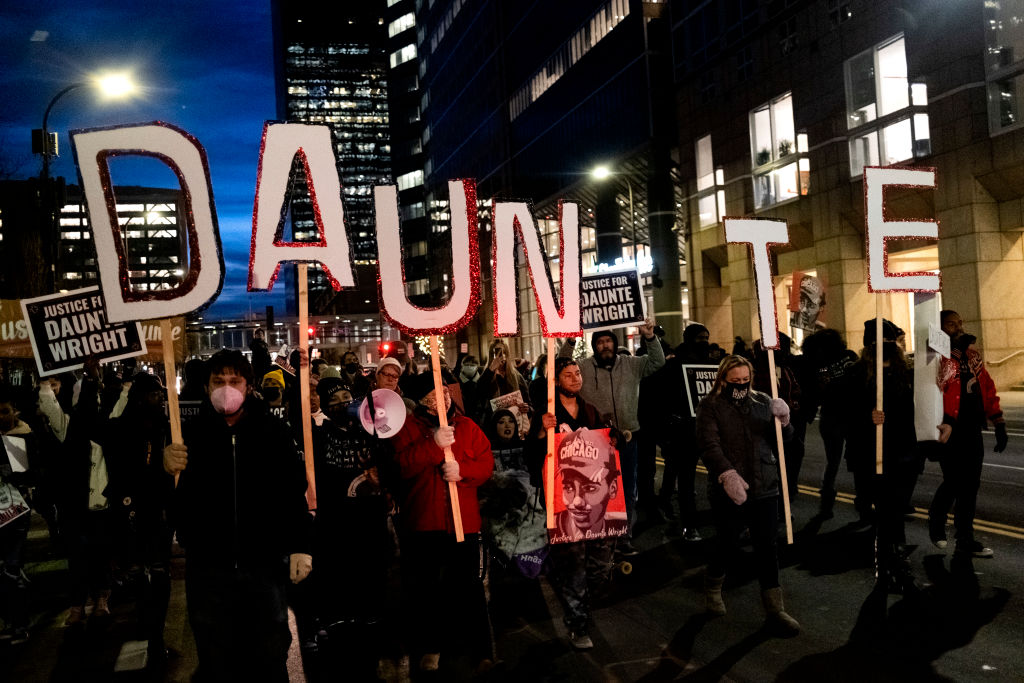For the fourth time in the last four years, Minnesota is trying a police officer for excessive use of force in a highly-publicized case watched by people around the world. In three of the four cases, an officer killed a black man during an alleged misdemeanor stop in the Twin Cities metropolitan area.
On April 11, 2021, Kim Potter, a former police officer from Brooklyn Center, Minnesota was training a new officer, Anthony Luckey, when they pulled over twenty-year old Daunte Wright. Luckey told Wright he was questioning him for displaying in his white Buick both an air freshener from his rearview mirror and expired license plate tabs. While searching for his records during the traffic stop, officers discovered an outstanding warrant for Wright’s arrest based on his failure to appear in court on a gross misdemeanor weapons charge. Upon police request, Wright opened his driver side door and began to exit the vehicle. By this time, another officer had arrived on the scene to assist Potter and Luckey. As Luckey began to handcuff Wright, Wright attempted to re-enter his own vehicle while officers struggled to restrain him.
Potter, standing behind the officers and Wright, shouted three “taser” warnings, but instead drew her service weapon and fired one bullet. She fatally shot Wright in his lungs and heart. Wright immediately gasped, “Ah, he shot me.” Wright also recognized what she had done, using expletives and crying out, “I just shot him… I grabbed the wrong f***ing gun… I’m going to go to prison… I killed a boy.”
Body camera footage captured on tape the entire encounter. Potter shot Wright as the Derek Chauvin trial was underway in Minneapolis, of which Brooklyn Center is a suburb. Days of protests against the shooting of Wright followed in Minnesota.
Neither the government nor the defense dispute that Potter made a mistake. The question for the jury will be whether Potter’s error in shooting rather than tasering Wright and thereby causing his death rose to the level of recklessness or negligence.
The state has pointed out differences between Potter’s gun and taser that it alleges justify the charges in this case. For example, Potter positioned her gun on the right side of her body and drew her weapon with her right hand. By contrast, Potter positioned her taser on the left side of her body and drew her taser with her left hand. Potter’s gun and taser were different colors and different textures, with the handgun featuring a unique grip. The taser also required Potter to manually turn a safety switch. Potter had received training in taser and firearm protocols during her twenty-six years as a veteran on the force.
In pretrial proceedings, Potter’s attorneys argued she did not act recklessly, used reasonable force and expressed immediate remorse. Indeed, her attorneys have argued that Potter acted reasonably in shooting Wright under the relevant facts. Potter’s attorneys have tried to place responsibility for the situation on Wright, whom they argue endangered the lives of the police officers on the scene. The trial judge rejected Potter’s motion to dismiss part of the state’s complaint.
Potter faces charges of first and second degree manslaughter and a statutory maximum prison sentence of fifteen years for the most serious charge. However, the state has already filed a notice of its intent to seek an upward sentencing departure based on Potter’s alleged abuse of authority and endangerment of other people’s lives during the deadly encounter.
Minnesota attorney general Keith Ellison took over the case for the county prosecutor, as he did with the Derek Chauvin murder trial. In what has become a recurring new pattern, the state deputized private attorneys to act as special prosecutors in the Potter case.
The court completed jury selection last week. Nine of the twelve jurors seated are white. The trial, which will be livestreamed by national media, begins today.
The Potter trial involves tragic facts and somewhat unsettled law. The case will be an important test of whether juries, historically reluctant to indict and convict police officers in excessive force cases, are focusing a more exacting eye on purported police misconduct.
Rachel K. Paulose is a 1997 graduate of Yale Law School and a former US attorney for the District of Minnesota (2006-08).


















